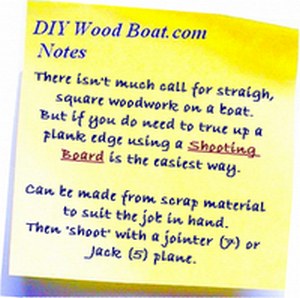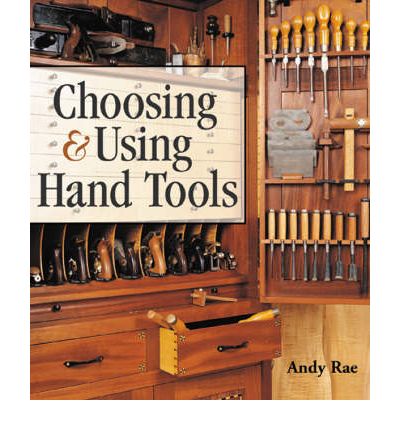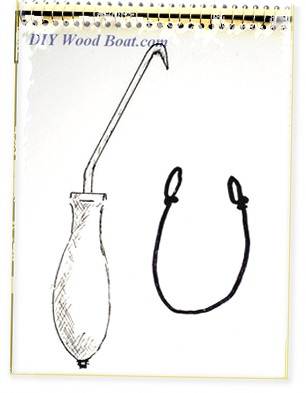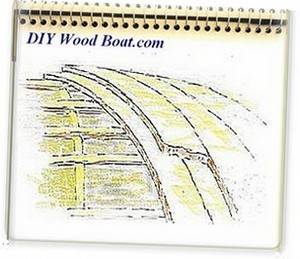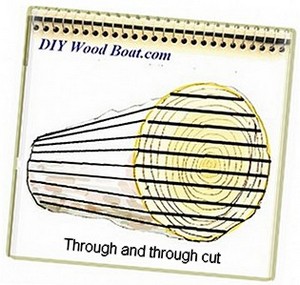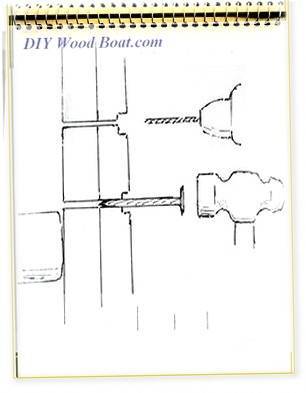- Home
- Boat Building
- Restoration
- Tools
- Bench Planes
- Caulking Irons
- Clamps
- Sharpening
Sharpening and Honing
How to sharpen and hone woodworking tools.
A must read for anyone wishing to build, restore or repair a wooden boat.
- Newly bought tools rarely come with a honed edge.
- Trying to work with blunt tools will be a frustrating business
- Honing often and lightly to insure good cutting edge will save time.
- For many woodworkers the honing process can be akin to a moment of meditation.
Like many DIY'ers I’m eager to
get on with the job.
The sharpening process is something to get out of the way as quickly as possible.
However, there have been times when, after a hard week at the day job
my
mind hasn’t been as sharp as it should be.
And that is when I've made mistakes.
I've cut a miter the wrong way
or put the tenon on the wrong end or
something equally stupid.
That, I've
found is the perfect time to stop and do some tool
sharpening.
It’s
amazing how therapeutic it can be.
Half an hour sat quietly going through my tools, honing the edges and I'm ready to get going again and so are my tools.
affiliate linksSharpening Stones.
Some woodworkers use wet-or-dry sandpaper to sharpen their tools.
This can be done using sheets of successively finer grits on a flat base such as a sheet of glass.
However, the time and expense of constantly having to replace the paper are probably why most use stones.
Oil Stones have long been the favoured sharpening method in the west.
The natural, quarried “Arkansas” (pronounced ‘Arkan-saw’) oilstones are legendary for their quality.
They keep their shape and flatness with little maintenance and will last a lifetime.
However they do cut slower than waterstones.
Oil stones do require lubricating to speed the cutting and reduce clogging.
Diamond Stones made from diamond particles bonded to steel or plastic are very popular among those who use them.
They cut quickly and are lubricated with water.
The coarser grits are ideal for flattening the backs of tools and for maintain the flatness of water stones.
While the finer grits are not so common diamond paste can be used for fine honing.
Water Stones have always been more popular In Asia.
The Japanese water stone is has microscopic particles of quartz suspended in a clay matrix.
As you sharpen the clay slowly dissolves to expose fresh quartz particles.
As the quartz particles are always fresh and sharp the stones cut faster.
However as the stone wears it must be periodically flattened.
They are available in many grits from 800 to 8000 the finest.
They can be flattened quite quickly using a rough piece of wet or dry silicon carbide paper or carborundum powder on a piece of glass however, a diamond stone is a lot easier to use.
Waterstones must be soaked before use and if possible kept moist so they will build up slurry in use.
affiliate linksSlipstones and Files are small stones used for sharpening carving chisels.
They are available in many section shapes, the teardrop and cone shapes are the most popular and convenient.
Grades of Grit are indicated by number starting with low numbers for the coarsest grit to high numbers for fine grit.
The most usual grades available are, from 800 for coarse, 1000 for medium, 1200 for fine and extra fine grits of 6000-8000.
The two finer grades are sometimes known as silver and gold stones.
affiliate linksHoning Guides.
Ideally we should all learn how to sharpen all those cutting edges easily and well by hand.
Being able to hone your tool immediately on a stone without having to set up a jig is quick and satisfying.
The technique of holding a tool at a consistent bevel angle is not that difficult, however it does require practice.
The problem is that you need to maintain the same exact bevel angle every time or you will create a series of bevels at each sharpening attempt.
Fortunately for those without the confidence or practice there
are numerous
honing guides on the market.
These will, once the blade is set up correctly ensure that you get a perfect angle to that bevel.
affiliate linksFlattening the Back.
Flattening the back of a chisel or plane blade is as important as honing the bevel.
Good quality tools should be sold with a flat or almost flat back.
However, it is wise to make sure that the back of your tool is flat by honing it.
Fortunately it’s not the whole of the back that needs to be flat just a small area along the cutting edge, but it is up to you how much you wish to flatten.
If the back of the blade is not perfectly flat it will be impossible to remove the burr formed when you hone the bevel.
Finish off with a fine stone to give a flat mirror finish.
You also need to make sure that the edge of your plane’s cap iron/breaker/chipper/chip breaker is flat,
Any gaps between it and the blade will trap shavings causing clogging.
The Bevel Edge.
Most chisels, bench and block plane blades are manufactured with single bevel angled at 25°.
While this angle is fine for cutting softwoods the edge is somewhat on the weak side for cutting hardwoods.
This is one of the reasons most woodworkers will hone a secondary bevel of about 35° at the very edge.
Another good reason for a narrow secondary bevel is that it is quicker and easier to sharpen as there is less metal to remove.
Once you have decided on the best angle for your tools it is simplest to stick to it.
There are several honing guides which have ingenious systems for setting the angles, squaring the base and even setting skews and cambers.
With the more simple honing guides you'll have set it by eye and experiment.
Check the blade to be sure that it is staying square.
You can use a try square and a fine felt tip pen to draw a guide line on the back of the blade.
On the final honing it’s a good idea to very slightly round of the very corners of plane blades.
This will eliminate a sharp corner marking the wood.
It goes without saying that the more metal you need to remove the coarser the should be the grit of the stone you start with.
For final honing use a fine grit.
Whatever type of stone being used always clean the blade before switching grits to avoid contaminating a fine grit stone with coarse grit.
When a burr forms all along the back of the blade you know that it is time to move to a finer grit.
This burr will become finer as you move to finer stones but you will be able to feel it catch your fingernail.
To remove the burr alternately rub back of blade flat on the stone then the bevel edge until the burr drops off.
to find a Veritas Mk II honing guide on
Stropping.
Finishing off by stropping will put that extra polish on the cutting edge which, will help it retain its edge and ensure that all those minute bits of burr are removed.
Leather is the traditional material used for stropping, however any fine textured surface would do.
If you have suitable strips of leather it is a simple matter to tack it onto thick piece of wood.
However, combination strops with coarse to fine leather, ready made can be bought quite cheaply.
You can use a fine stropping paste on the initial strop but not on the finishing final strop and don’t allow the paste to contaminate the finishing leather.
If your final honing stone was 8000 grit (gold) it may not be necessary to strop and do not use a stropping paste as this will probably be coarser than the stone.
affiliate linksGrinding.
Some woodworkers prefer their blades hollow ground as they are marginally easier to hone, there being less metal to remove.
However as the hollow ground tool is repeatedly sharpened the hollow will disappear and will require re-grinding.
While grinding is fast and effective, for most of us it is usually reserved for major alterations such as repairing damage.
The danger of using a grinding wheel is over heating the cutting edge.
A sure sign of over heating is if the metal begins to turn blue.
If this happens it means that it has lost its temper and will not hold and edge.
The only cure is to grind away all the blue area and start again.
Use the wheel at a slow speed and if there is no water trough, dip the blade regularly in water to keep it cool.
Once the tool is ground, hone it on an oil stone until a bright line appears all along the cutting edge and the heel.
As you will have to constantly remove the blade from the wheel to cool it, you will need some way to ensure it goes back on to the wheel at the same angle each time.
Use a guide clamped on to the back of the blade, this can be just a piece of wood which will act as a stop against the tool rest.
affiliate links
Gouges.
As far as I know only Tormek has produced a honing jig for gouges, designed to be used on their water-cooled sharpening systems.
This is where you will have to learn to hone by hand.
For out-cannel gouges those with the bevel on the outside of the curve place the stone sideways and use a figure of eight movement across the stone with enough rocking motion to hone evenly across the edge.
Then use an appropriately sized slipstone to remove the burr.
For in-cannel gouges use the slipstone to hone the bevel then the flat stone for removing burr.
affiliate linksJapanese Blades.
Because of the way Japanese blades are made, with a hard steel cutting strip laminated to a softer steel backing there is no need to hone a secondary bevel.
The soft iron backing is usually hollow ground to minimize the amount of material that has to be removed when honing.
However, this does complicate things when, eventually sharpening begins to creep into the hollow ground area.
While maintaining this hollow isn’t strictly necessary, to do so is a skilled process.







